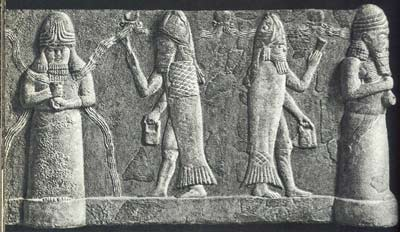The ancient history of the Sumerians, Assyrians and Babylonians all are dominated by reliefs of figures that feature a 1/2 human 1/2 fish resemblance.


The figurines above came from Nineveh, that show the creature 1/2 fish 1/2 man Oannes.
The original text has been lost, but was later recorded with diligence by an ancient Greek named Berossus, that was first translated in 1876. The text records the traditional history of mankind known by the Babylonians. Their development was possible because of the knowledge that was given to mankind by an Amphibious creature, 1/2 man and 1/2 fish, named Oannes. Oannes was from the Musari or the Annedoti creatures. Oannes first appeared to mankind during the reign of Ammenon of Babylon. The word, "Annedoti" means repulsive, while the word "Mursarus" means abomination. Evidently Oannes and the Annedoti were extremely offensive to mankind. They were literally ugly monsters, that repulsed man, but were totally benign. What Oannes did was to depart to man knowledge.
The text below is part of that translation;
In the first year there made its appearance, from a part of the Erythraean sea which bordered upon Babylonia, an animal endowed with reason, who was called Oannes. (According to the account of Apollodorus) the whole body of the animal was like that of a fish; and had under a fish's head another head, and also feet below, similar to those of a man, subjoined to the fish's tail. His voice too, and language, was articulate and human; and a representation of him is preserved even to this day.
This Being in the day-time used to converse with men; but took no food at that season; and he gave them an insight into letters and sciences, and every kind of art. He taught them to construct houses, to found temples, to compile laws, and explained to them the principles of geometrical knowledge. He made them distinguish the seeds of the earth, and showed them how to collect fruits; in short, he instructed them in every thing which could tend to soften manners and humanize mankind. From that time, so universal were his instructions, nothing has been added material by way of improvement. When the sun set, it was the custom of this Being to plunge again into the sea, and abide all night in the deep; for he was amphibious.
After this there appeared other animals like Oannes, of which Berossus promises to give an account when he comes to the history of the kings.
NOTE; The Erythraean Sea is now called the Arabian Sea.
Can the history of man be believed from the stories, myths traditions of ancient people. Is it possible that at the very beginning there existed 2 distinct species of mankind? They were able to coexist.
Enki's, the Sumerian God, in the relief above, pictures him atop his Ziggurat, with his signature water pouring form his image. This water depicts his power over the Abzu. The Ziggurats were thought to have large basins of water, at their top. Were the Abzu, and their water ceremony, more than just a religious act, but a significant part of the these Great Gods life? Were the Abzu necessary for the Great Gods existence? Just as Oannes had to return each night to live in the Ocean, did the Anunnaki have to return to the Abzu, which contained a transformed water, since they were a considerable distance from the Ocean.
Here is shown a Great God ascending out of the Abzu which is located atop the Ziggurat.
In Canaan, Dagan is seen as a half fish, and there are reliefs throughout the ancient world that show a half man, half fish God, that is thought to be Dagan.. Could it be that the Anunnaki take a form other than man in the underworld? Is Dagan one such creature?
In Exodus 33:20, Yahweh is speaking to Moses; "No man can see me and live". Is the reason that Dagan/Yahweh is unwilling to show himself, is that he is an abomination to mankind? That his appearance doesn't project an image of worship, but projects horror. The ancient figure below illustrates Dagan.
In the Sumerian language, priest or priestess, has been translated, into the word "changeling". The Sumerians, in their reliefs of the Anunnaki were again merely drawing what they observed, or were they myths? Were the Anunnaki able to transform into a human form? The fishman figure below were common in the ancient world.

What makes the stories believable is that these fish like humans were drawn in reliefs throughout ancient history, and that they were considered an abomination by man. If you were writing a myth, why would you make these creatures repulsive to man, and yet beneficial?

What makes the stories believable is that these fish like humans were drawn in reliefs throughout ancient history, and that they were considered an abomination by man. If you were writing a myth, why would you make these creatures repulsive to man, and yet beneficial?
It appears that the Anunnaki chose the earth because of it's water. As all life requires water the Great gods also require water to survive. Not just to drink, but the use of water in some way extends their life, when in the presence of the ABZU.
For further information on the ABZU of Sumeria go to blog site;
http://trueancienthistory.blogspot.ca/2013/05/the-sumerian-abzu.html
For further information on the ABZU of Sumeria go to blog site;
http://trueancienthistory.blogspot.ca/2013/05/the-sumerian-abzu.html

No comments:
Post a Comment
Note: only a member of this blog may post a comment.